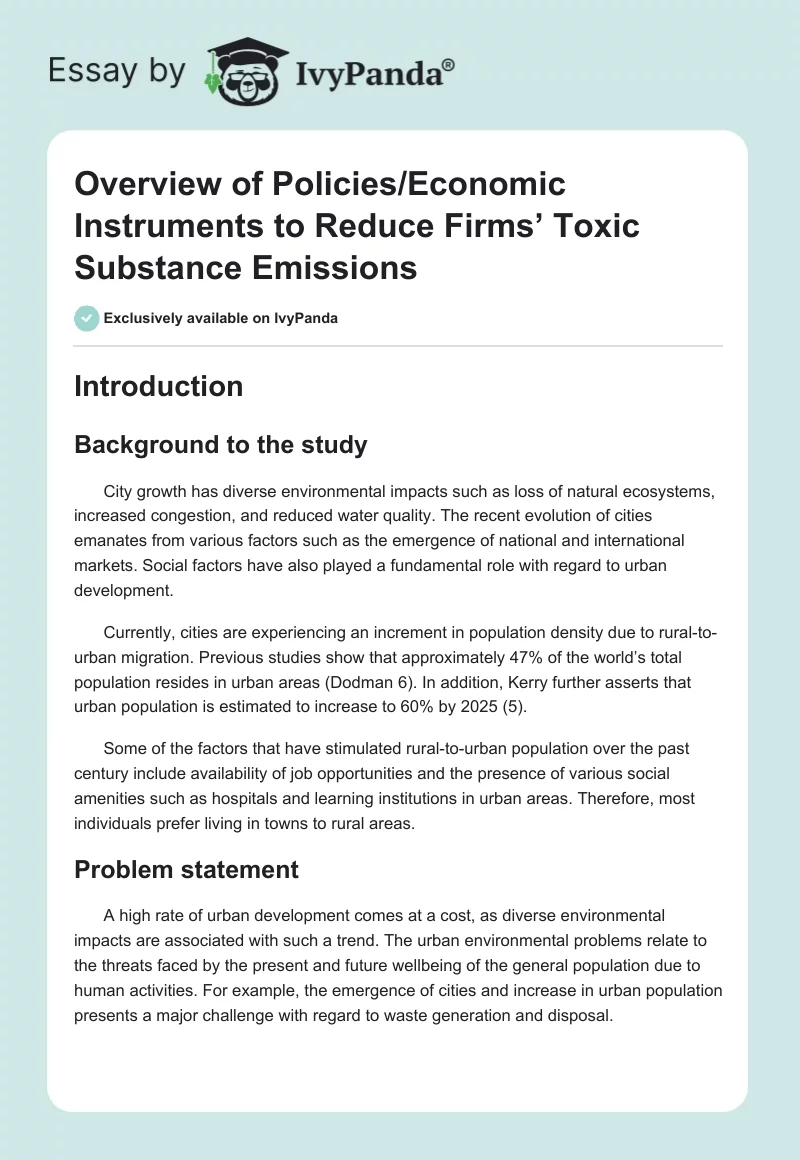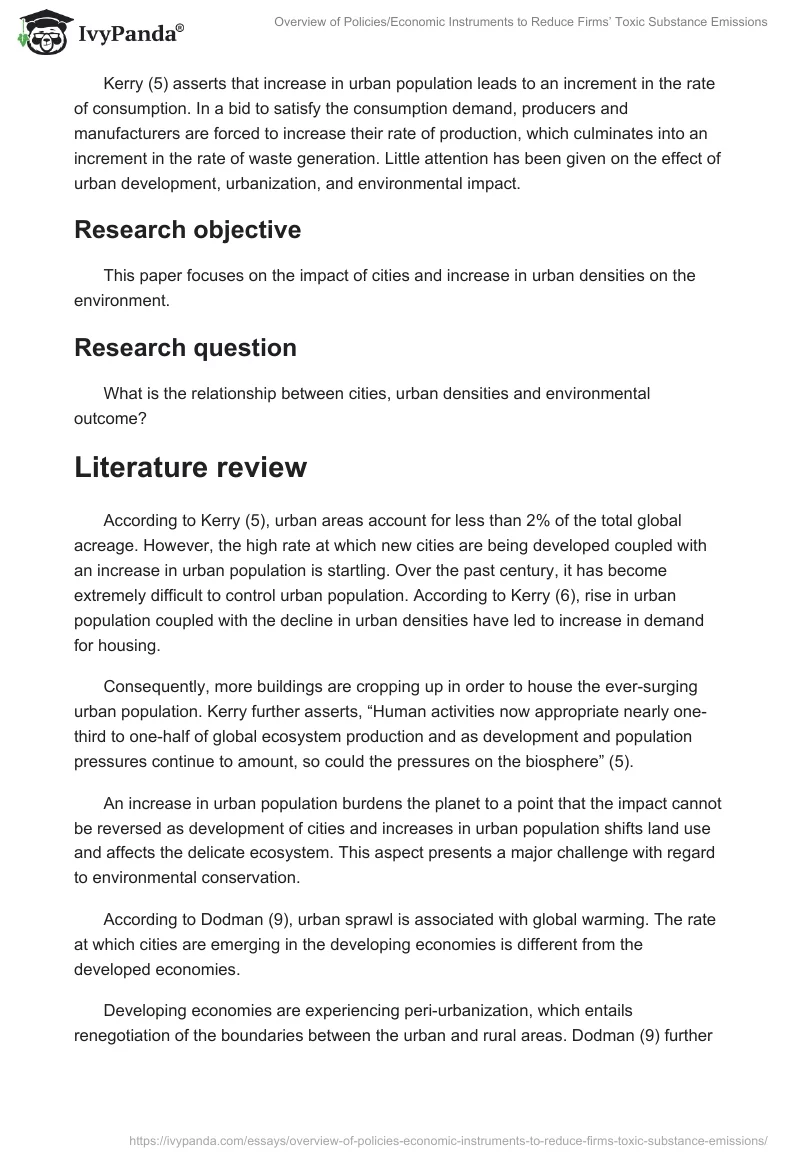Introduction
Background to the study
City growth has diverse environmental impacts such as loss of natural ecosystems, increased congestion, and reduced water quality. The recent evolution of cities emanates from various factors such as the emergence of national and international markets. Social factors have also played a fundamental role with regard to urban development.
Currently, cities are experiencing an increment in population density due to rural-to-urban migration. Previous studies show that approximately 47% of the world’s total population resides in urban areas (Dodman 6). In addition, Kerry further asserts that urban population is estimated to increase to 60% by 2025 (5).
Some of the factors that have stimulated rural-to-urban population over the past century include availability of job opportunities and the presence of various social amenities such as hospitals and learning institutions in urban areas. Therefore, most individuals prefer living in towns to rural areas.
Problem statement
A high rate of urban development comes at a cost, as diverse environmental impacts are associated with such a trend. The urban environmental problems relate to the threats faced by the present and future wellbeing of the general population due to human activities. For example, the emergence of cities and increase in urban population presents a major challenge with regard to waste generation and disposal.
Kerry (5) asserts that increase in urban population leads to an increment in the rate of consumption. In a bid to satisfy the consumption demand, producers and manufacturers are forced to increase their rate of production, which culminates into an increment in the rate of waste generation. Little attention has been given on the effect of urban development, urbanization, and environmental impact.
Research objective
This paper focuses on the impact of cities and increase in urban densities on the environment.
Research question
What is the relationship between cities, urban densities and environmental outcome?
Literature review
According to Kerry (5), urban areas account for less than 2% of the total global acreage. However, the high rate at which new cities are being developed coupled with an increase in urban population is startling. Over the past century, it has become extremely difficult to control urban population. According to Kerry (6), rise in urban population coupled with the decline in urban densities have led to increase in demand for housing.
Consequently, more buildings are cropping up in order to house the ever-surging urban population. Kerry further asserts, “Human activities now appropriate nearly one-third to one-half of global ecosystem production and as development and population pressures continue to amount, so could the pressures on the biosphere” (5).
An increase in urban population burdens the planet to a point that the impact cannot be reversed as development of cities and increases in urban population shifts land use and affects the delicate ecosystem. This aspect presents a major challenge with regard to environmental conservation.
According to Dodman (9), urban sprawl is associated with global warming. The rate at which cities are emerging in the developing economies is different from the developed economies.
Developing economies are experiencing peri-urbanization, which entails renegotiation of the boundaries between the urban and rural areas. Dodman (9) further opines that developing countries are characterized by the emergence of slum areas, which have poor planning and waste disposal systems.
Consequently, these areas have adversely affected farmland. Moreover, such urban growth increases environmental pollution hence increasing climate change.
Research methodology
In a bid to understand the relationship of urban cities, urban densities, and environmental outcome, a comprehensive research methodology was utilized. Research methodology guides the research in collecting, analyzing, and interpreting the data, and thus the findings of the study are improved (Creswell & Clark 67). Both qualitative and quantitative research designs were utilized.
Qualitative research design enabled the researcher to collect a broad range of data from diverse sources. Quantitative research design enabled the researcher to quantify the data collected, hence simplifying the findings of the study to the target audience.
Secondary methods of data collection were used. The researcher relied on reports and studies that have been already been published. However, it was ensured that only credible reports and studies are relied on, which was motivated by the need to improve the findings of the study.
Discussion and analysis
Development of cities affects the environment in a number of ways. First, building cities leads to loss of evapotranspiration from the earth’s surface. Development of cities increases the acreage of urban land that is covered with an impermeable surface due to the building materials used.
Some of the materials that are used include asphalt and concrete, which prevent water from penetrating into the earth’s crust or evaporating into the atmosphere. This aspect leads to increment in local temperatures. This increment in temperature in the cities is referred to as the “urban heat island effect” (Foley 571). According to (Foley 571), dense and large cities are 100 C warmer than the rural areas.
Previous studies show that change in land use and the high rate of urbanization are the main reasons for the current increment in temperatures. The development of cities and growth in urban population leads to increment in the volume of greenhouse gas emission.
Currently, greenhouse gas emissions are considered the major factors increasing climate change. However, loss of vegetation cover on the earth’s surface has significant implications on the environment. Building impermeable surfaces increase surface flow, thus draining substantial volumes of contaminants into the water systems.
According to Marshall et al, commercial and residential zones in cities have high levels of phosphorous, lead, zinc, and nitrogen (284). Moreover, their impermeable nature increases the risk of flooding. The surface runoff from the urban areas into the local water systems leads to degradation of the coastal waters and other water systems, which affects both human and aquatic life adversely.
For example, the quality of water is adversely affected by the heavy metals hence leading to oxygen depletion, which kills fish. On the other hand, surface runoff increases blooms of cyanobacteria hence increasing the risk of waterborne diseases.
Development of most cities affects agricultural land, as new buildings are not usually built on the existing urban areas, but on areas around the cities. As a result, the agricultural land and forests around the cities is destroyed.
A study conducted in the United States shows that agricultural land has declined from “448 million hectares to 403.5 million hectares during the period ranging between 1961 and 2009, which represents a 10% decline in the size of agricultural land” (Foley 7).
Decline in the available land for agricultural production will translate into adverse environmental consequences and reduced agricultural yields. Destruction of such forests and wetlands affects the local water system adversely.
For example, destruction of wetlands reduces the amount of water available for human consumption and agricultural purposes. On the other hand, deforestation leads to increment in the rate of climate change, which arises from the fact that the greenhouse gases released into the atmosphere such as carbon dioxide are not cleaned up.
Growth in cities and increment in urban population densities lead to increment in the level of congestion. Moreover, the ever-increasing number of automotives and other forms of transportation such as aircrafts and trains are increased in order to address the urban populations’ transport demands.
Consequently, the volume of greenhouse gases emitted into the atmosphere increases significantly, which increases the rate of global warming. Global warming has been cited as one of the main causes of variations in climate patterns. For example, increase in the earth’s temperature increases the risk of icecaps melting. As a result, the risk of rise in sea level and hence flooding increases.
Conclusion
This study has illustrated the relationship of expansion and development of new cities, increase in urban population and the environment. The analysis shows that the environment is very vulnerable to urban development and increase in urban population. From the discussion above, it is evident that expansion of cities has a significant impact on the environment.
For example, expansion of cities leads to environmental degradation and destruction. Moreover, delicate ecosystems in the areas surrounding the cities are destroyed in order to give way to new buildings. Most of the ecosystems that are destroyed have been developed over thousands of years. Therefore, such ecosystems cannot be easily replaced.
The local water systems are affected by the surface runoffs, which have substantial deposits of heavy metals and other water pollutants. Consequently, both aquatic life and human beings are affected; for example, the pollutants lead to oxygen deprivation in the water in addition to stimulating growth of different bacteria.
Expansion of cities and growth in urban population also leads to decline in the size of land available for agricultural production, which may culminate into a decline in the local population’s income. Moreover, destruction of wetlands and deforestation affects the prevailing biodiversity.
The study also shows that expansion of cities and urban density increases the rate of global warming, which arises from the fact that substantial volumes of greenhouse gases are emitted into the atmosphere hence increasing local temperatures. This aspect is evidenced by the existence of urban heat islands in large cities such as New York; therefore, climatic patterns are affected adversely.
Recommendations
It is evident that there is a strong positive correlation between growth in cities, urban densities, and environmental outcomes. Considering the fact that cities and the environment play a critical role in the economic development of a country, it is imperative for policy developers to incorporate strategies that will lead to a balance between growth in cities, urban densities, and the environment.
Some of the strategies that can be incorporated include integrating sustainable land use designs, promoting utilization of pervious building materials and integrating strategies that can limit rural to urban migration. Governments can achieve this goal by developing various economic activities in rural areas.
Additionally, government should develop roads and other infrastructures in the rural areas. As a result, rural to urban migration will be minimized.
Works Cited
Dodman, David 2009, Urban density and climate change. Web.
Foley, Jonathan. “Global consequences of land use.” Science Magazine 309.5734 (2012): 570-574. Print.
Kerry, Carole 2012, Competing for land: The relationship between urban development and agriculture for Lancaster and Seward counties. Web.
Marshall, Julian, Thomas McKone, Elizabeth Deakin, and William Nazaroff 2004, Inhalation of motor vehicle emissions: effects of urban population and land area. Web.


